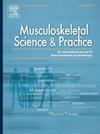Cervical range of motion in individuals with and without chronic subacromial pain syndrome: a cross-sectional study
IF 2.2
3区 医学
Q1 REHABILITATION
引用次数: 0
Abstract
Objective
To compare cervical range of motion (ROM) between asymptomatic individuals and those with subacromial pain syndrome (SAPS), and to investigate its relationship with shoulder pain, disability, and other clinical factors.
Methods
A cross-sectional study was conducted with 50 individuals with SAPS and 50 asymptomatic controls (both sexes, aged 32–66). The Shoulder Pain and Disability Index (SPADI) assessed shoulder disability, and cervical ROM was measured using a cervical range of motion (CROM) device.
Results
Individuals with SAPS had significantly reduced cervical ROM compared to controls, confirmed by Student's t-test or Mann-Whitney test. Large effect sizes were observed (Cohen's d = 1.08 and 1.65 for right bending and extension; Mann-Whitney effect size = −0.44 to −0.56 for other movements). Pearson correlations revealed a significant inverse relationship between cervical ROM and SPADI scores (r = −0.42 to −0.61). Chi-square analysis indicated that shoulder pain was associated with cervical ROM deficits (Χ2 = 6.83 to 27.75), with prevalence ratios ranging from 1.5 (flexion) to 4.25 (left rotation) higher in individuals with SAPS. These deficits were also associated with longer duration of shoulder pain, higher neck pain intensity, and older age.
Conclusion
Individuals with SAPS have reduced cervical mobility compared to asymptomatic individuals, especially for cervical rotation. Cervical ROM deficits were more prevalent in individuals with SAPS and correlated with greater shoulder disability. Clinical factors such as duration of shoulder pain, neck pain intensity, and age contribute to these deficits. These findings highlight the need to assess cervical mobility in patients with SAPS.
有或没有慢性肩峰下疼痛综合征的个体的颈椎活动度:一项横断面研究
目的比较无症状与肩峰下疼痛综合征(SAPS)患者的颈椎活动度(ROM),并探讨其与肩痛、失能及其他临床因素的关系。方法采用横断面研究方法,选取50例SAPS患者和50例无症状对照者(男女,年龄32 ~ 66岁)。肩关节疼痛和失能指数(SPADI)评估肩关节失能,颈椎活动度(CROM)装置测量颈椎ROM。结果与对照组相比,SAPS患者的颈椎ROM明显减少,经学生t检验或Mann-Whitney检验证实。观察到较大的效应量(Cohen’s d = 1.08和1.65);其他运动的Mann-Whitney效应值= - 0.44 ~ - 0.56)。Pearson相关性显示,颈椎ROM和SPADI评分呈显著负相关(r = - 0.42至- 0.61)。卡方分析显示肩痛与颈椎ROM缺损相关(Χ2 = 6.83 ~ 27.75), SAPS患者的患病率为1.5 ~ 4.25(左旋)。这些缺陷还与肩痛持续时间较长、颈痛强度较高和年龄较大有关。结论:与无症状者相比,SAPS患者的颈椎活动度降低,尤其是颈椎旋转。颈椎ROM缺损在SAPS患者中更为普遍,并与肩功能障碍相关。诸如肩痛持续时间、颈痛强度和年龄等临床因素会导致这些缺陷。这些发现强调了评估SAPS患者颈椎活动度的必要性。
本文章由计算机程序翻译,如有差异,请以英文原文为准。
求助全文
约1分钟内获得全文
求助全文
来源期刊

Musculoskeletal Science and Practice
Health Professions-Physical Therapy, Sports Therapy and Rehabilitation
CiteScore
4.10
自引率
8.70%
发文量
152
审稿时长
48 days
期刊介绍:
Musculoskeletal Science & Practice, international journal of musculoskeletal physiotherapy, is a peer-reviewed international journal (previously Manual Therapy), publishing high quality original research, review and Masterclass articles that contribute to improving the clinical understanding of appropriate care processes for musculoskeletal disorders. The journal publishes articles that influence or add to the body of evidence on diagnostic and therapeutic processes, patient centered care, guidelines for musculoskeletal therapeutics and theoretical models that support developments in assessment, diagnosis, clinical reasoning and interventions.
 求助内容:
求助内容: 应助结果提醒方式:
应助结果提醒方式:


